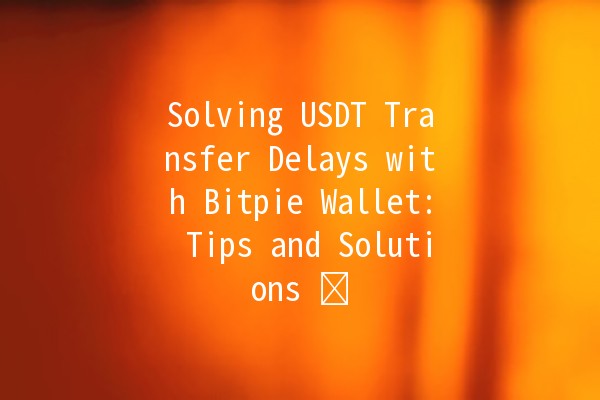
In the world of cryptocurrencies, USDT (Tether) is one of the most widely used stablecoins, allowing users to perform transactions seamlessly across various platforms. However, delays in USDT transfers can cause significant frustration, especially for frequent traders and users. Bitpie Wallet, a popular choice among cryptocurrency users, is acknowledged for its features and userfriendly interface. This article delves into how Bitpie Wallet addresses USDT transfer delays and provides practical tips to enhance your transfer experience.
Understanding USDT Transfer Delays
Before exploring solutions with Bitpie Wallet, it's crucial to understand why USDT transfer delays may occur. Common reasons include:

By recognizing these factors, users can take proactive steps to minimize transfer delays.
How Bitpie Wallet Enhances USDT Transfers
Bitpie Wallet has integrated several features aimed at improving the efficiency of USDT transactions. Here are some ways Bitpie Wallet addresses those delays:
Bitpie Wallet employs advanced technology to enhance communication with the blockchain. This means transactions are processed more quickly and with greater accuracy, minimizing the likelihood of delays during busy periods.
Application Example:
When sending USDT, users can experience faster confirmation times compared to standard wallets. This is especially beneficial during hightraffic conditions or when dealing with timesensitive transactions.
To avoid delays caused by low gas fees, Bitpie Wallet allows users to customize gas fees for their transactions according to their urgency. Users can select higher fees for faster processing or lower fees when they can afford to wait.
Application Example:
For instance, if a user needs to transfer USDT quickly to capitalize on a market opportunity, they can choose to pay a higher fee, ensuring their transaction gets mined faster.
Bitpie Wallet supports multiple blockchains, including Ethereum and TRON, to give users flexibility in choosing the network for their USDT transactions. Each network may offer different speeds and fees, allowing users to select the best option based on their needs.
Application Example:
If a user notices congestion on the Ethereum network, they can switch to the TRON network to complete their USDT transfer more quickly.
Bitpie Wallet features an intuitive interface that simplifies the transfer process. Users can easily track the status of their USDT transactions, view transaction history, and manage their assets without complicated navigation.
Application Example:
Users can quickly access their pending transactions and adjust their gas fees or switch networks if they notice an impending delay, providing them with tools to manage their transfers effectively.
While security is paramount, Bitpie Wallet also ensures that their additional security measures do not significantly slow down transactions. With features like twofactor authentication and biometric security, users can feel confident in their transfer's safety without the burden of long delays.
Application Example:
A trader can authorize a USDT transaction using biometric verification without experiencing substantial wait times, ensuring both security and efficiency during their trading process.
Tips for Improving USDT Transfer Speed in Bitpie Wallet
Besides utilizing the capabilities of Bitpie Wallet, users can take additional steps to ensure their USDT transfers are quick and efficient:
Keep an eye on the blockchain network status to see if there is high congestion. Avoid making transfers during peak times.
When transferring USDT, manually set higher gas fees to ensure your transaction gets processed quickly, especially during busy times.
Depending on the transaction amount and urgency, choose the appropriate blockchain for your transfer (Ethereum, TRON, etc.) to optimize speed and fees.
Ensure that your Bitpie Wallet app is always up to date. Updates often include performance enhancements and bug fixes that can improve transaction speeds.
Whenever possible, make direct transfers from wallet to wallet instead of routing through exchanges, as fewer intermediary steps can lead to faster transactions.
Frequently Asked Questions About USDT Transfer Delays
USDT transfer delays can be caused by several factors, including network congestion, low gas fees, walletspecific optimizations, and the processing times of exchanges. Understanding these elements can help users mitigate delays in their transactions.
To check the status of your transaction, you can use a block explorer relevant to the blockchain you are using (such as Etherscan for Ethereum), or you can track your history directly within the Bitpie Wallet app to see the current status of your pending transaction.
If your USDT transfer is taking longer than expected, first check the transaction status using a block explorer. If you suspect it’s due to a low gas fee, you might need to wait or consider initiating a new transaction with a higher fee.
Once a USDT transaction is confirmed on the blockchain, it cannot be reversed. It’s essential to doublecheck recipient addresses and transaction details before sending funds.
To reduce transaction fees, you can customize your gas fees and choose times when the network is less congested. However, be cautious about setting fees too low, as this may lead to delays.
Yes, transferring USDT during busy periods can expose you to increased fees and longer wait times. Users may need to set higher fees to ensure their transactions are prioritized by miners, or they may experience delays beyond their control.
Through understanding and utilizing the features provided by Bitpie Wallet, users can effectively minimize delays in USDT transfers. By implementing the provided tips and optimizing their transaction settings, users will significantly enhance their cryptocurrency transaction experience.

